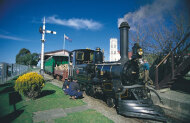Timaru
Timaru, whose Māori name roughly translates to "place of shelter," lives up to its name, offering a welcoming haven on the South Island's east coast. Explore the vibrant town centre, where inviting cafes and restaurants provide stunning views over the bay. Admire Timaru's beautifully preserved Edwardian buildings, a testament to its rich heritage. Immerse yourself in Māori culture at the Te Ana Māori Rock Art Centre, home to an impressive collection of ancient Māori rock art. For a unique and nostalgic experience, take a short drive north to the Pleasant Point Museum and Railway, a renowned New Zealand preservation railway offering a step back in time. If your journey takes you south, don't miss a worthwhile detour to Harlaxton House for lunch and a leisurely stroll through its enchanting gardens. Timaru offers a delightful blend of coastal charm, historical intrigue, and picturesque landscapes, making it a truly rewarding stop on your South Island adventure.

Pleasant Point Museum & Railway
Pleasant Point Museum and Railway is an award-winning homage to the region's past. Board the Fully restored steam train at the original Railway Station, built in 1875, which is in the center of the quaint country town of Pleasant Point. Travel down the track to the Keanes Crossing complex where there is vintage railway rolling stock; including steam locomotives an 85 ton Ab699 built in 1922 and a 16 ton D16 built-in 1878. One of the world's only Model T Ford Railcars runs daily throughout the summer months (check the timetables). At the historic museum, you can walk through and marvel at the interesting displays of railway memorabilia. Also, have a look at the displays of old computers and at the vintage printery see how newspapers were printed in years gone by. Many of the machines here are more than 100 years old. Some of the unique features of this award-winning attraction include New Zealand's only restored half-birdcage carriage built-in 1895, locomotive and wagon turntables, and the former 1912 Washdyke signal box.
